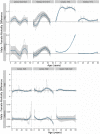Women live longer than men even during severe famines and epidemics
- PMID: 29311321
- PMCID: PMC5789901
- DOI: 10.1073/pnas.1701535115
Women live longer than men even during severe famines and epidemics
Abstract
Women in almost all modern populations live longer than men. Research to date provides evidence for both biological and social factors influencing this gender gap. Conditions when both men and women experience extremely high levels of mortality risk are unexplored sources of information. We investigate the survival of both sexes in seven populations under extreme conditions from famines, epidemics, and slavery. Women survived better than men: In all populations, they had lower mortality across almost all ages, and, with the exception of one slave population, they lived longer on average than men. Gender differences in infant mortality contributed the most to the gender gap in life expectancy, indicating that newborn girls were able to survive extreme mortality hazards better than newborn boys. Our results confirm the ubiquity of a female survival advantage even when mortality is extraordinarily high. The hypothesis that the survival advantage of women has fundamental biological underpinnings is supported by the fact that under very harsh conditions females survive better than males even at infant ages when behavioral and social differences may be minimal or favor males. Our findings also indicate that the female advantage differs across environments and is modulated by social factors.
Keywords: epidemics; famines; gender; mortality; survival.
Copyright © 2018 the Author(s). Published by PNAS.
Conflict of interest statement
The authors declare no conflict of interest.
Figures



Comment in
-
Reply to Delanghe et al.: Iron status is not likely to play a key role in the gender survival gap under extreme conditions.Proc Natl Acad Sci U S A. 2018 May 1;115(18):E4150. doi: 10.1073/pnas.1801481115. Epub 2018 Apr 17. Proc Natl Acad Sci U S A. 2018. PMID: 29666225 Free PMC article. No abstract available.
-
Iron status as a confounder in the gender gap in survival under extreme conditions.Proc Natl Acad Sci U S A. 2018 May 1;115(18):E4148-E4149. doi: 10.1073/pnas.1800932115. Epub 2018 Apr 17. Proc Natl Acad Sci U S A. 2018. PMID: 29666245 Free PMC article. No abstract available.
References
-
- Austad SN. Why women live longer than men: Sex differences in longevity. Gend Med. 2006;3:79–92. - PubMed
-
- Glei DA, Horiuchi S. The narrowing sex differential in life expectancy in high-income populations: Effects of differences in the age pattern of mortality. Popul Stud (Camb) 2007;61:141–159. - PubMed
-
- Kalben BB. Why men die younger: Causes of mortality differences by sex. N Am Actuar J. 2000;4:83–111.
MeSH terms
Grants and funding
LinkOut - more resources
Full Text Sources
Other Literature Sources
Miscellaneous

